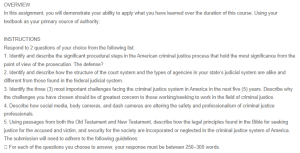Structure and Challenges of the U.S. Criminal Justice System
Question 1
How the Structure of the Court System and the Types of Agencies in my State’s Judicial System are Alike and Different from those Found in the Federal Judicial System
In the United States, the court system functions under what is referred to as a dual court system, essentially meaning that there are two separate court systems, namely state court and federal courts. Both of these court systems are set up in a way that they operate independently and under different jurisdictions and legal frameworks. It is notable that they also have some similarities. For instance, federal courts have jurisdiction over cases that involve federal laws, conflicts between states, patent law, constitutional law cases that involve ambassadors, and certain areas, for example, bankruptcy (Neubauer & Fradella, 2018). Secondly, federal courts usually consist of the U.S. Supreme Court, the highest court, trial courts, and the U.S. Court of Appeals (intermediate appellate courts). Thirdly, when it comes to cases handled by federal courts, they usually have limited jurisdiction in that they can only handle cases that are sanctioned by either federal statutes or the Constitution.
On the other hand, state courts usually handle cases that involve state laws, mainly consisting of family law, criminal cases, personal injury and contract dispute cases. Secondly, when it comes to the structure of state courts, there is a similarity with federal courts because they also have trial courts, intermediate appellate courts and a state supreme court (Neubauer & Fradella, 2018). The difference in regards to the structure is that sometimes, the trial courts in state courts are divided into lower and major trial courts. Lastly, since state courts are the primary venue for the larger percentage of legal disputes, they usually have extensive jurisdiction over a broader range of cases.
Question 2
Three (3) Most Important Challenges Facing the Criminal Justice System in America in the Next Five (5) Years
The first two challenges are cybercrime and digital security. Technology has advanced rapidly, especially with the invention of artificial intelligence. Besides, the rapid evolution of technology means this area will only grow in importance over the next five years. This technology has shown to have unlimited potential in its capabilities in almost all areas. Unfortunately, these innovations also give sophistication to all kinds of cybercrime, which range from online fraud, identity theft, deepfakes, and hacking, just to name a few. Further, these technologies could make it easy for criminals who use the internet to stalk others, sell illegal items, spread fake information, and recruit people into their illegal groups, as well as online predators who prey on children or potential victims of trafficking, among others. Continuous innovation means that law enforcement will have to be constantly adapting to new threats (Lima, 2017). Law enforcement agents will also have to acquire training so that they gain the specialized knowledge required to deal with the new threats.
The third challenge is racial disparities and biases in the criminal justice system. Racial disparities are no doubt still a huge problem in America, and they are evident in the criminal justice system in the arrests, incarceration rates, and sentencing as well not to mention police brutality and killings (Smith et al., 2021). There is no equality under the law and this problem will only continue to persist over the next five or more years till racism is eradicated in the country. Further, the legitimacy and ethical standards of this institution will continue to be questioned.
References
Lima, D. (2017). Could AI agents be held criminally liable: artificial intelligence and the challenges for criminal law. SCL Rev., 69, 677.
Neubauer, D. W., & Fradella, H. F. (2018). America’s courts and the criminal justice system (p. 648). Brooks/Cole Publishing Company.
Smith, C. M., Goldrosen, N., Ciocanel, M.-V., Santorella, R., Topaz, C. M., & Sen, S. (2023). Racial disparities in criminal sentencing vary considerably across federal judges. Journal of Institutional and Theoretical Economics, 179. https://doi.org/10.1628/jite-2023-0005
ORDER A PLAGIARISM-FREE PAPER HERE
We’ll write everything from scratch
Question
OVERVIEW
In this assignment, you will demonstrate your ability to apply what you have learned over the duration of this course. Using your textbook as your primary source of authority;

Structure and Challenges of the U.S. Criminal Justice System
INSTRUCTIONS
Respond to 2 questions of your choice from the following list:
1. Identify and describe the significant procedural steps in the American criminal justice process that hold the most significance from the point of view of the prosecution. The defense?
2. Identify and describe how the structure of the court system and the types of agencies in your state’s judicial system are alike and different from those found in the federal judicial system.
3. Identify the three (3) most important challenges facing the criminal justice system in America in the next five (5) years. Describe why the challenges you have chosen should be of greatest concern to those working/seeking to work in the field of criminal justice.
4. Describe how social media, body cameras, and dash cameras are altering the safety and professionalism of criminal justice professionals.
5. Using passages from both the Old Testament and New Testament, describe how the legal principles found in the Bible for seeking justice for the accused and victim, and security for the society are incorporated or neglected in the criminal justice system of America.
The submission will need to adhere to the following guidelines:
For each of the questions you choose to answer, your response must be between 250–300 words.

